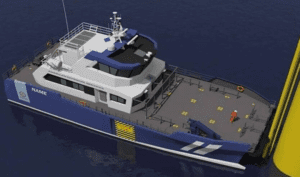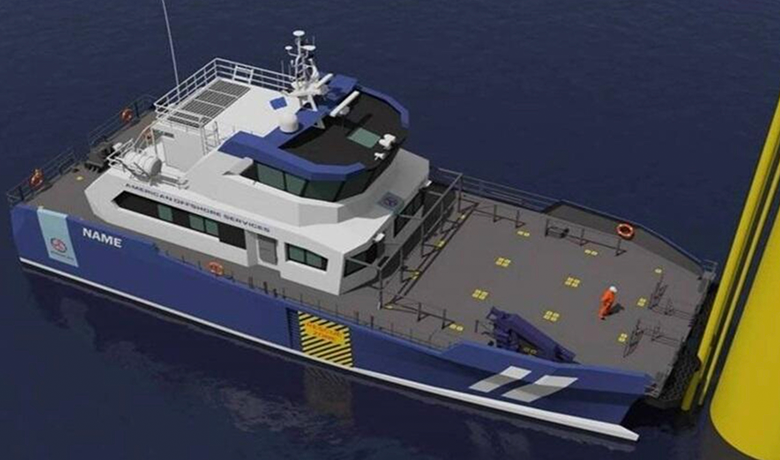
IPS drives.
American Offshore Services (AOS) has partnered with Blount Boats on the construction of four new hybrid-ready crew transfer vessels (CTVs) for offshore wind farms.
The 99-foot aluminum catamarans will be substantially larger than the three existing U.S.-flagged CTVs, which are less than 65 feet long. The new boats will have seating for 24 technicians and overnight crew quarters, according to Marcia Blount, president of Blount Boats of Warren, R.I.
AOS is a joint venture between Northern Offshore Services (NOS), one of the largest CTV operators in Europe, and Sea.O.G., a renewable energy and logistics firm that merged with Crosby Tugs last year.
The vessels will be built to a completely new “G-class” design developed by NOS and Grovfjord Mek Verksted, a shipyard in Norway. The lead vessel is tentatively scheduled for delivery in May 2023, with subsequent deliveries every five to six months, Blount said.
AOS has contracts to service four offshore wind farms, although the company has not said where the vessels will operate.
“The hard work we all have put in together has resulted in our first won contracts,” David Kristensson, owner of NOS, said in a statement. “The first contract in a new market is always something special and I cannot wait for what happens tomorrow and the day after that.”
The new G-class CTVs will be powered by four 700-hp Tier 3 Volvo Penta D13 engines paired with Volvo Penta IPS900 drives. They also will be equipped with a Volvo Penta GPS-based dynamic positioning system with integrated joystick controls.
“The quad IPS configuration is ideally suited to the unique requirements for these highly specialized boats, providing a unique combination of high top speeds to minimize transit times, excellent slow-speed torque, and superior grip when loading and unloading crew and gear at the turbines,” said Jens Bering, vice president of marine sales for Volvo Penta of the Americas.
“The hull design and IPS drives will also provide a smooth and stable ride for passengers and crew under all sea conditions, an important consideration for workers’ productivity when they arrive at their worksite,” he continued.
The hulls will be built with a dedicated room for battery banks and other electric propulsion components needed for a future hybrid conversion, Blount said.
Blount Boats has plenty of experience building CTVs. It completed the first American CTV, Atlantic Pioneer, for Atlantic Wind Transfers in 2016. Five years later, it delivered the slightly larger Atlantic Endeavor for the same operator.
Based on the current timelines, Blount expects construction to begin on the lead AOS boat in February 2022.

